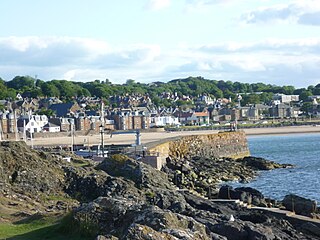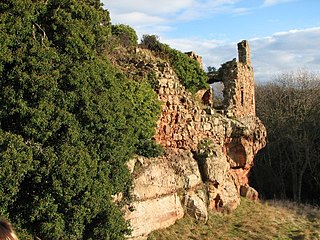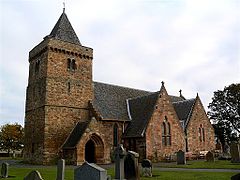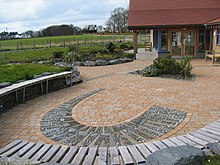
East Lothian is one of the 32 council areas of Scotland, as well as a historic county, registration county and lieutenancy area. The county was called Haddingtonshire until 1921.

Lothian is a region of the Scottish Lowlands, lying between the southern shore of the Firth of Forth and the Lammermuir Hills and the Moorfoot Hills. The principal settlement is the Scottish capital, Edinburgh, while other significant towns include Livingston, Linlithgow, Bathgate, Queensferry, Dalkeith, Bonnyrigg, Penicuik, Musselburgh, Prestonpans, Tranent, North Berwick, Dunbar, Whitburn and Haddington.

The Firth of Forth is the estuary, or firth, of several Scottish rivers including the River Forth. It meets the North Sea with Fife on the north coast and Lothian on the south.

North Berwick is a seaside town and former royal burgh in East Lothian, Scotland. It is situated on the south shore of the Firth of Forth, approximately 20 miles (32 km) east-northeast of Edinburgh. North Berwick became a fashionable holiday resort in the nineteenth century because of its two sandy bays, the East Bay and the West Bay, and continues to attract holidaymakers. Golf courses at the ends of each bay are open to visitors.

The Britons, also known as Celtic Britons or Ancient Britons, were an indigenous Celtic people who inhabited Great Britain from at least the British Iron Age until the High Middle Ages, at which point they diverged into the Welsh, Cornish, and Bretons. They spoke Common Brittonic, the ancestor of the modern Brittonic languages.
Aberlady Bay in East Lothian, Scotland lies between Aberlady and Gullane.

Gullane is a town on the southern shore of the Firth of Forth in East Lothian on the east coast of Scotland. There has been a church in the village since the ninth century. The ruins of the Old Church of St. Andrew built in the twelfth century can still be seen at the western entrance to the village; the church was abandoned after a series of sandstorms made it unusable, and Dirleton Parish Church took its place.

Eyebroughy is a small, rocky islet in the Firth of Forth, 200 m off East Lothian, Scotland.

Kingston is a small hamlet near North Berwick in East Lothian, Scotland.

Auldhame and Scoughall are hamlets in East Lothian, Scotland. They are close to the town of North Berwick and the village of Whitekirk, and are approximately 25 miles (40 km) east of Edinburgh.

Luffness Castle, also known as Luffness House, is a house built in a former fortification near the village of Aberlady, East Lothian, Scotland.
The George Waterston Memorial Centre and Museum is a local museum in Fair Isle, Scotland.

Fast Castle is the ruined remains of a coastal fortress in Berwickshire, south-east Scotland, in the Scottish Borders. It lies 4 miles (6.4 km) north west of the village of Coldingham, and just outside the St Abb's Head National Nature Reserve, run by the National Trust for Scotland. The site is protected as a Scheduled Ancient Monument.

Innerwick is a coastal civil parish and small village, which lies in the east of East Lothian, five miles from Dunbar and approximately 32 miles from Edinburgh.

The Scottish Ornithologists' Club (SOC) is a Scottish ornithological body, founded in March 1936 at the premises of the Royal Scottish Geographical Society. As of 2008, the SOC has 2,200 members. The Club runs the Scottish Birds Records Committee, which maintains a list of birds recorded in Scotland. In 2007, the club was awarded the Silver Medal by the Zoological Society of London. The SOC publishes a quarterly journal entitled Scottish Birds.

The Aberlady, Gullane and North Berwick Railway was promoted independently to develop settlements between Longniddry and North Berwick in East Lothian, Scotland. It opened its line from a junction near Longniddry as far as Gullane in 1898, but never succeeded in financial terms, and it never completed its line to North Berwick, which already had a branch railway.

The settlement of Great Britain by diverse Germanic peoples, who eventually developed a common cultural identity as Anglo-Saxons, changed the language and culture of most of what became England from Romano-British to Germanic. This process principally occurred from the mid-fifth to early seventh centuries, following the end of Roman rule in Britain around the year 410. The settlement was followed by the establishment of the Heptarchy, Anglo-Saxon kingdoms in the south and east of Britain, later followed by the rest of modern England, and the south-east of modern Scotland. The exact nature of this change is a topic of on-going research. Questions remain about the scale, timing and nature of the settlements, and also about what happened to the previous residents of what is now England.

Kilspindie Castle lies north of the village of Aberlady, in East Lothian, Scotland; the remains of the castle are behind the Victorian St Mary's Kirk. An early castle was destroyed in the 16th century, and the rebuilt tower was pulled down by the 18th century. Little more than a few scattered stones of the base of a doorway with a length of wall punctuated by oval gun loops remain. The area is protected as a scheduled monument. Another ruin called "Kilspindie Castle" was at Butterdean near Coldingham.

Prior to the 5th century AD, most people in Great Britain spoke the Brythonic languages, but these numbers declined sharply throughout the Anglo-Saxon period, when Brythonic languages were displaced by the West Germanic dialects that are now known collectively as Old English.






















